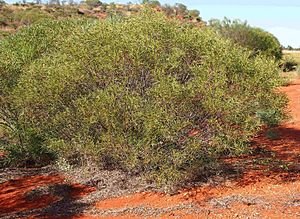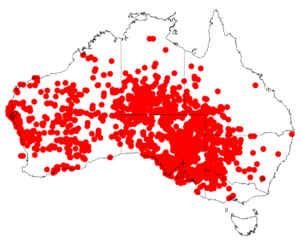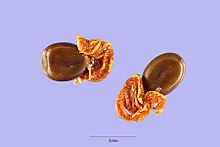Umbrella wattle facts for kids
Quick facts for kids Umbrella wattle |
|
|---|---|
 |
|
| A. ligulata flowers | |
| Scientific classification | |
| Genus: |
Acacia
|
| Species: |
ligulata
|
 |
|
| Occurrence data from AVH | |
The Acacia ligulata, also known as the umbrella wattle or sandhill wattle, is a type of Acacia plant. It's a thick shrub that grows all over mainland Australia. This plant is very common and is not considered rare or in danger of disappearing.
Other common names for it include umbrella bush, marpoo, dune wattle, small coobah, watarka, and wirra.
The name Acacia comes from the Greek word akakia, which means "sharp thorns." The part of the plant that looks like a leaf is called a phyllode. Its shape gave the species the name ligulata, which means "strap-like" or "with a small tongue" in Latin.
Contents
What it Looks Like
The Acacia ligulata is a shrub that can grow straight up or spread out. It usually reaches 2 to 4 meters (about 6 to 13 feet) tall and 3 meters (about 10 feet) wide. Sometimes, it looks like a dome shape. Its branches often grow right from the ground.
The bark at the bottom of the plant can be grooved, but the rest of it is smooth. Its smaller branches have yellowish ridges and sometimes have fine hairs.
Phyllodes (Leaf-like Parts)
What look like leaves on this plant are actually called phyllodes. They are light green to blue-green. They are usually long and narrow, slightly curved, and about 3–10 centimeters (1 to 4 inches) long. They are also 4-10 millimeters (about 0.15 to 0.4 inches) wide. These phyllodes are thick, smooth, and can get wrinkled when it's dry.
Each phyllode has a clear yellowish vein down the middle. The other veins are hard to see. The tip of the phyllode is blunt and has a small, hard point called a mucro that points downwards. You can also find two to four small glands on the phyllode, usually below the middle and near the tip.
Flowers and Seeds
The flowers are yellow to orange and shaped like small balls, about 5-6 millimeters (0.2 inches) across. They grow alone or in groups of 2 to 5 on short stalks called peduncles, which are 4-10 millimeters long. Each flower head has about 20 tiny flowers.
The seed pods, which are a type of legume, are light brown and curved. They are 5–10 centimeters (2 to 4 inches) long and 5-10 millimeters (0.2 to 0.4 inches) wide. These pods are squeezed in between the seeds and break easily into single-seed pieces. The stalk of the seed pod is orange to red. The seeds inside are black and oval-shaped, up to 3.5x3.5 millimeters in size. They lie lengthwise inside the pod.
Plant Family
The A. ligulata is part of a group of 12 Acacia species called the A. bivenosa group. It was once thought to be a type of A. salicina. However, it's different because its branches are stiff, its top part is not divided, and its seed pods have special features.
Where it Grows and Lives
The Acacia ligulata is one of the most common Acacia species in Australia. It grows widely across central and southern Australia, mostly in dry areas south of the Tropic of Capricorn.
Charles Sturt, an explorer, once described the areas where this plant grows as "huge and almost impossible sand-ridges of a fiery red." These areas, like the Sand Plain Mulga Shrublands in north-west New South Wales, have scattered shrubs and grassy clumps.
You can find A. ligulata in many places. It grows on sand dunes, at the edges of salt lakes, on floodplains, and in areas with mulga and bluebush plants. It also lives in woodlands and mallee communities.
How it Lives in Nature (Ecology)
A. ligulata often grows in thick groups on sand dunes. When it's not on dunes, it grows more spread out. This plant grows quickly and helps to make sand dunes stable. It also recovers fast after things like overgrazing by animals. It can sometimes spread very quickly, which means it might become a weed in some areas.
This plant can survive in Australia's hottest and driest climates. It grows where rainfall is less than 200 millimeters (about 8 inches) per year and can handle light frost.
The roots of the A. ligulata are home to witchetty grubs. The leaves are food for the larvae of the Nacaduba biocellata butterfly. Cattle eat the phyllodes, and rabbits often eat the lower parts of the plant. Kangaroos and farm animals use these plants for shelter. When herbivores eat the young plants, it can stop new ones from growing.
Reproduction and Life Cycle
The A. ligulata flowers from May to November, depending on where it is in Australia. Sometimes, you can see flowers at other times of the year too. Seeds are made between November and January.
The seeds have fleshy parts that help them get spread around by birds, like the red wattlebird. They are also spread by ants, a process called myrmecochory. Ants can carry the seeds up to 180 meters (about 590 feet) away. They can spread seeds within an area of 3000 square meters (about 32,000 square feet) around their nests.
Uses
People use A. ligulata in many ways. It can be planted as a hedge or a windbreak. It's also used to make sandy areas stable and to help land grow back after damage, like controlling erosion. It can even grow in salty or alkaline soils. Farmers have used it as emergency food for their livestock.
Indigenous Australians have used this plant for a long time. They would mix its ashes with dried and powdered leaves from another plant, Duboisia hopwoodii, to make a substance called pituri for trading. The gum from the Acacia ligulata was eaten, and its seeds were roasted and ground to make a type of bread called damper. The leaves and bark were also used as medicine to treat colds, chest infections, and other general illnesses.
Gallery
-
A. ligulata habit, Sturt National Park near Tibooburra, New South Wales (NSW)
See also
 In Spanish: Acacia paraguas para niños
In Spanish: Acacia paraguas para niños







